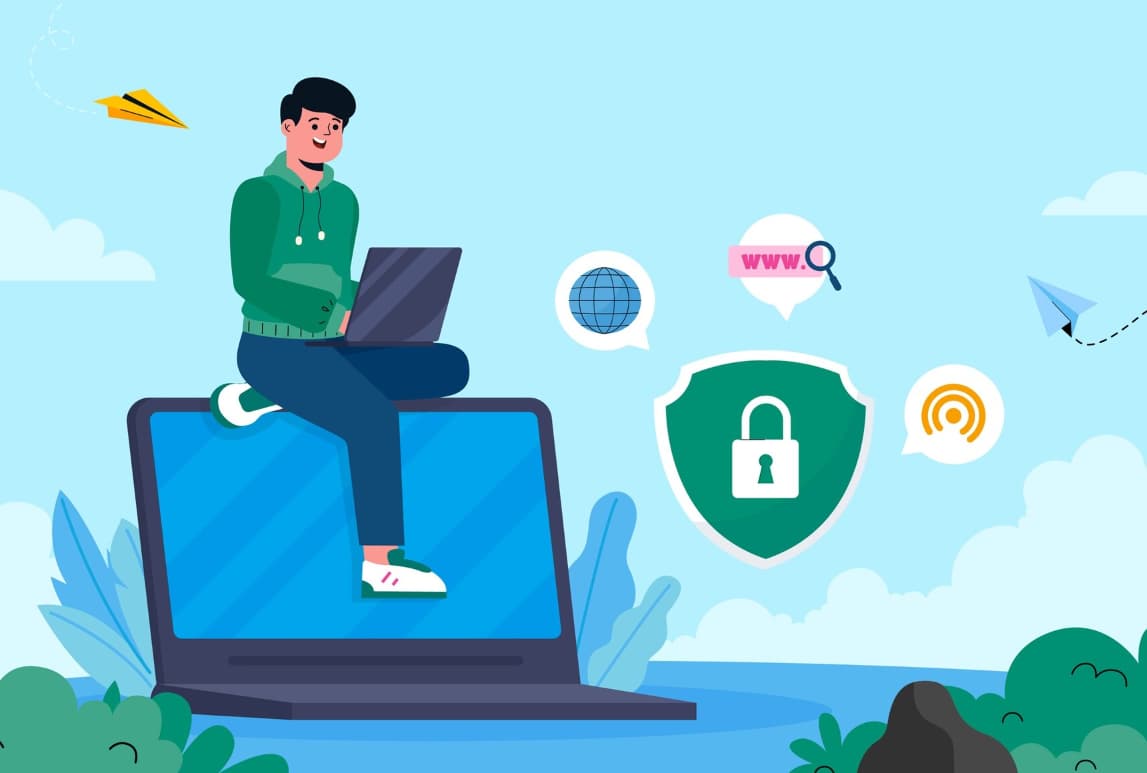The beauty of digital connectivity is that everything is at your fingertips through a tap of a screen or pressing keys. But exposure to the internet does come with its drawbacks.
Namely, the more we rely on the internet and the more we use it to access various services our lives depend on, the more we’re exposed to its dangers.
Personal Cybersecurity Practices for Everyday Users

The need to remain safe and secure paves the way for personal cybersecurity education. Nowadays, personal cybersecurity has become a crucial skill set for safeguarding our digital footprints.
And it can be learned through security awareness training. But what is security awareness training and how does it help protect us?
Well, that’s today’s subject, so sit back and let’s see how security, or cybersecurity, awareness training helps ensure online experiences.
What is Security Awareness Training?

Security Awareness Training is a critical component in the cybersecurity ecosystem, designed to equip individuals and organizations with the knowledge and skills needed to protect themselves against a wide array of cyber threats.
This educational process goes beyond mere information dissemination; it’s about fostering a deep understanding of the potential risks in the digital landscape and instilling best practices for digital hygiene.
The Need for Security Awareness Training
The cyber threat landscape is not static; it’s an ever-evolving battleground where threats grow in sophistication and scale, making it imperative for individuals to not only understand these threats but also know how to protect against them.
Let’s explore the factors responsible for the need for security awareness training:
-
Evolving Cyber Threats
The digital world is a double-edged sword. While it offers unparalleled convenience and connectivity, it also opens up a Pandora’s box of cyber threats.
These threats are no longer confined to the stereotypical virus attacks of the early internet days.
Today, we’re facing a spectrum of cyber threats from phishing scams, which trick individuals into divulging sensitive information, to ransomware attacks that lock users out of their data and demand payment for its release.
Moreover, the advent of sophisticated techniques like man-in-the-middle (MITM) attacks, where attackers intercept and alter communications between two parties, and advanced persistent threats (APTs), which are prolonged and targeted cyberattacks, has raised the stakes higher than ever.
These threats are not just a concern for large corporations; they’re a real and present danger to everyday users.
-
The Human Element
One of the most overlooked aspects of cybersecurity is the human element. Technology alone cannot safeguard against cyber threats; it requires the active participation and vigilance of every user within your organization.
This is where security awareness training comes into play. It’s about educating individuals on the nature of these threats, the tactics used by cybercriminals, and the best practices for staying safe online.
Security awareness training empowers users with the knowledge to recognize potential threats, such as identifying phishing emails or understanding the risks associated with using public Wi-Fi networks.
It also instills a sense of responsibility, encouraging users to adopt secure practices like regular software updates, the use of strong, unique passwords, and the importance of data backups.
-
Building a Culture of Security
Security awareness training goes beyond individual knowledge and practices; it’s about building a culture of security. In this culture, cybersecurity is not seen as a hindrance but as an integral part of daily digital interactions.
It promotes an environment where security practices are not just encouraged but are the norm, where sharing knowledge and best practices is commonplace, and where individuals feel empowered to take proactive steps in securing their digital footprint.
This culture of security is particularly important in the age of social media and interconnected digital lives, where a single compromised account can lead to a domino effect, endangering not just the individual but their contacts as well.
By fostering this culture, we not only protect ourselves but also contribute to a safer digital community.
The 8 Personal Cybersecurity Practices You Need
With that said, let’s outline the best cybersecurity practices you need to remain vigilant in the digital world.
-
Strong Passwords
The cornerstone of personal cybersecurity is strong, unique passwords for each of your accounts. A robust password should be a mix of letters, numbers, and special characters, making it difficult for attackers to crack.
Consider using a passphrase—a sequence of words or a sentence that is easy for you to remember but hard for others to guess. Additionally, leverage password managers to store and manage your passwords securely, ensuring you don’t reuse them across different sites.
-
Two-Factor Authentication (2FA)
Two-factor authentication adds a layer of security by requiring a second form of verification beyond just your password.
This could be a text message with a code, a biometric factor like a fingerprint, or a token generated by an authentication app. Enabling 2FA on all your accounts, especially those containing sensitive information, significantly reduces the risk of unauthorized access.
-
Regular Software Updates
Cybercriminals often exploit vulnerabilities in outdated software to gain unauthorized access to systems. Regularly updating your operating system, applications, and any software you use is crucial in closing these security gaps.
Enable automatic updates wherever possible to ensure you’re always running the latest, most secure versions.
-
Beware of Phishing Scams
Phishing scams are a prevalent method cybercriminals use to deceive individuals into revealing personal information, such as passwords and credit card numbers.
Be wary of unsolicited emails or messages that urge immediate action, such as clicking on a link or downloading an attachment. Verify the sender’s authenticity, and when in doubt, directly contact the organization through official channels.
-
Secure Wi-Fi Use
Unsecured Wi-Fi networks, especially public ones, are hotbeds for cybercriminal activities. When using public Wi-Fi, avoid accessing sensitive information or making financial transactions.
For home networks, ensure your Wi-Fi is secured with a strong password and WPA2 or WPA3 encryption. Consider using a Virtual Private Network (VPN) to encrypt your internet connection, adding an extra layer of security.
-
Data Encryption
Encrypting your data makes it unreadable to unauthorized users, providing a strong defense against data breaches and theft.
Use encryption tools to protect sensitive files on your computer and portable drives. For sensitive communications, use encrypted messaging apps that offer end-to-end encryption, ensuring that only the intended recipient can read your messages.
-
Regular Backups
Regular backups of your important data act as a safety net in case of a cyberattack, such as ransomware, or hardware failure. Use the 3-2-1 backup rule: keep at least three copies of your data, store two backup copies on different storage media, and keep one of them offsite or in the cloud.
-
Stay Informed
The cyber threat landscape is constantly evolving, with new threats emerging regularly. Stay informed about the latest cybersecurity threats and trends by following reputable cybersecurity news sources, attending webinars, and participating in online forums.
Knowledge empowers you to recognize potential threats and take proactive measures to protect yourself.
Wrapping Up:
Let’s reiterate one more time; personal cybersecurity is not optional but essential.
By adopting these cybersecurity practices, you’re not just protecting your personal information—you’re contributing to the broader effort to create a safer digital space for everyone.
Stay vigilant, stay informed, and continuously adapt to the ever-changing digital landscape.



